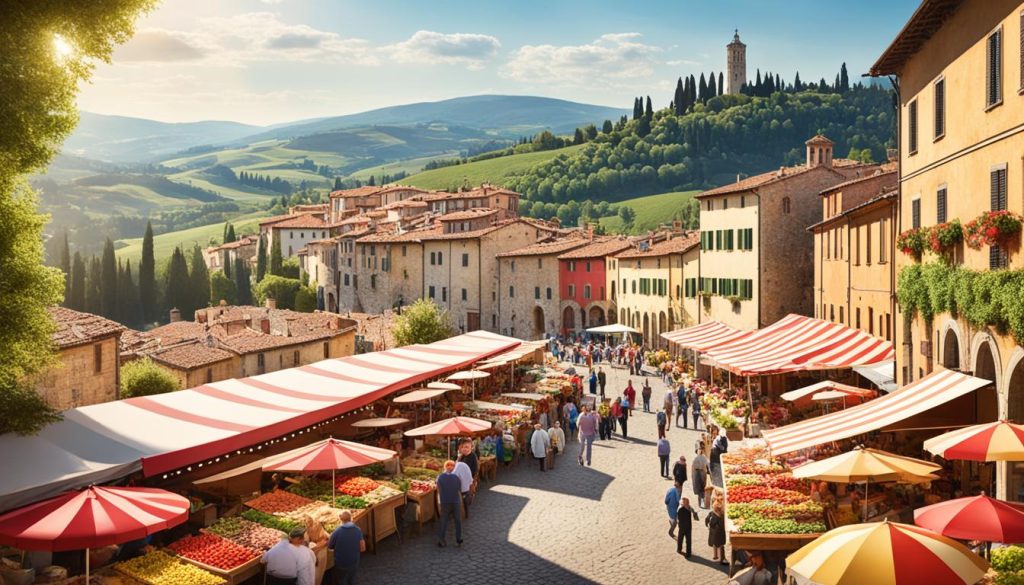Italy’s food market has a rich history tied to its culture and cuisine. The Italian gastronomy entices food lovers all over the globe. It’s known for both its traditions and modern twists.
- The Cultural Significance of Italian Cuisine
- Economic Contribution of the Food and Beverage Sector
- Emerging Trends in the Food and Beverage Industry in Italy
- Regulations and Standards in Italian Food Production
- Sustainability Practices Within the Industry
- Technological Advances in Food Manufacturing
- Exportation and Global Market Penetration
- Challenges Facing the Food and Beverage Industry in Italy
- Importance of Branding and Marketing in Italian Gastronomy
- Investment and Funding for F&B Start-Ups
- Case Studies of Successful Italian Food and Beverage Companies
- Culinary Tourism and Its Influence on the Economy
- Conclusion
At the heart of Italy’s food scene is a special mix of classic tastes and modern drinks. This includes everything from fine wines to creative cocktails. These drinks are as important as the meals they accompany.
In Italy, visitors find themselves in a world of delicious smells and tastes. These experiences underline Italy’s role as a key player in Italian gastronomy. This draws food enthusiasts to Italy, where they can dive into its rich food culture.
The Cultural Significance of Italian Cuisine
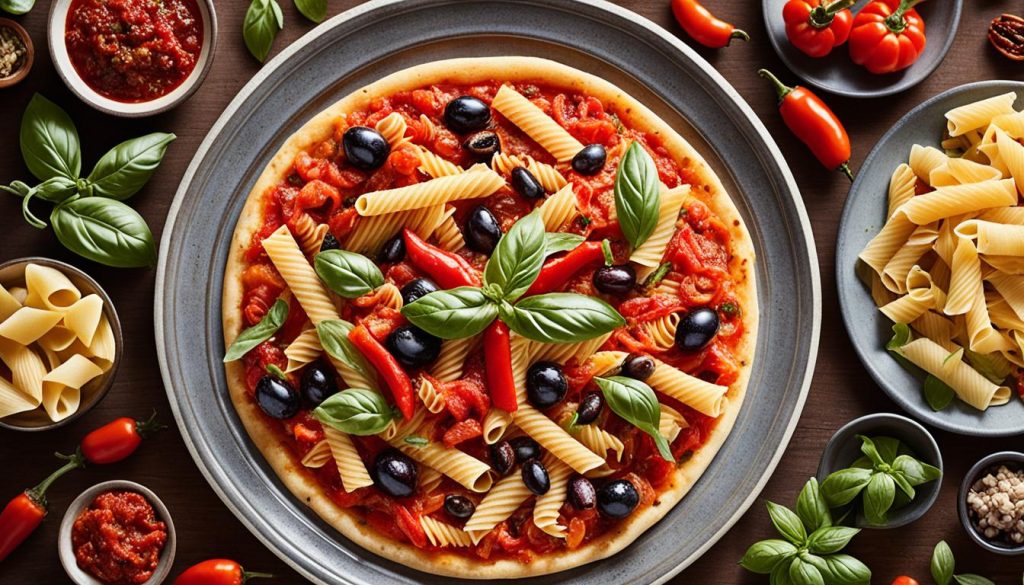
Italian cuisine is more than just delicious food; it’s a rich story woven through history and geography. It showcases diverse dishes from every corner of Italy, showcasing the nation’s pride in its food culture. This heritage strengthens the national identity and shares Italian cuisine’s influence worldwide. A deeper look into its history, regional delicacies, and global impact shows Italian food’s deep cultural importance.
The Historical Roots of Italian Cooking
The history of Italian cooking dates back to ancient Rome, leaving a lasting mark on the culinary world. Roman feasts showed the world the luxury and variety that Italian food is known for. Through time, cooking methods improved, ingredients varied, and a rich food culture developed. This has made Italian cuisine one of the most celebrated globally.
Region-Specific Specialities and Their Impact
Italy is home to diverse regional dishes, each with its unique flavours and cooking techniques. For example, Lombardy offers the hearty osso buco and Campania offers the fresh Caprese salad. This variety shows the country’s culinary richness. These regional dishes help keep cultural identities alive in Italy’s various areas.
- Lombardy’s rich, butter-based cuisine and the iconic risotto alla Milanese
- Tuscany’s rustic fare and the globally adored bistecca alla Fiorentina
- Sicily’s Arab-influenced dishes such as the ever-popular arancini
How Italian Food Culture Influences the Global Palette
Italian cuisine’s global influence is significant. Ingredients like olive oil, balsamic vinegar, and sun-dried tomatoes are now worldwide staples. Meanwhile, pizza and pasta are enjoyed in many forms around the globe. As Italian food culture mixes with other culinary traditions, it continues to evolve. This shows it’s a dynamic, living tradition that goes beyond any border.
Italian cuisine’s journey across the world has enriched global food cultures and sparked a universal admiration for Italy’s rich gastronomic legacy. Its ability to adapt while staying true to its roots shows its endless appeal and cultural importance. This essence keeps exciting the global palette, sharing the Italian way of enjoying great food and life.
Economic Contribution of the Food and Beverage Sector

The food and beverage industry is key to Italy’s economy. It makes a big economic impact and boosts food exports. This sector feeds the nation and supports its economy, reaching every part of Italy’s GDP.
The numbers show the industry is financially important. Food exports tell of Italy’s global culinary fame. Products with ‘Made in Italy’ are loved worldwide, sharing Italian culture far and wide.
- Export growth shows the world loves Italy’s food.
- The sector creates jobs, strengthening Italian communities.
- Its innovation meets rising global demand.
The future looks bright for this industry. Despite hurdles, it keeps strengthening Italy’s economy. It remains vital for Italy’s wealth. As the world changes, Italy’s food and beverage sector sees more chances to grow.
- Sustainable investments promise longer export life.
- New technology aims for better efficiency and quality.
- Diverse products meet changing tastes and demands worldwide.
Emerging Trends in the Food and Beverage Industry in Italy

The Italian food and beverage industry is changing. It’s moving towards healthier and more sustainable choices. This change reflects the new preferences of consumers who want healthier options.
Innovation in Health-Conscious Products
Italian producers are making more health-focused products. These include low-calorie foods and those rich in nutrients. They aim to meet the needs of health-aware consumers who don’t want to compromise on taste.
- Enriched pasta with added fibre and protein
- Organic snacks free from artificial additives
- Dairy alternatives catering to lactose intolerance and vegan diets
The Rise of Organic and Artisanal Offerings
There’s a growing demand for organic Italian food. People are choosing foods that are tasty and grown without harmful chemicals. Artisanal foods are also becoming popular. They offer unique flavours and traditional production methods.
- Small-batch cheeses from regional family farms
- Handcrafted cured meats using age-old recipes
- Organic olive oils with traceable provenance
Adapting to Changing Consumer Behaviors
The Italian food and beverage sector is keeping up with changing consumer habits. They’re not just reacting to changes but are also trying to predict future trends. This keeps Italian producers ahead in the industry.
- Investments in sustainable farming practices
- Development of new food preservation techniques to extend shelf life without compromising quality
- Enhanced packaging design focussing on both practicality and environmental considerations
Italy’s food and beverage industry remains innovative. Their efforts to keep their products authentic are making a difference. They are setting trends that appeal to health-conscious consumers worldwide.
Regulations and Standards in Italian Food Production
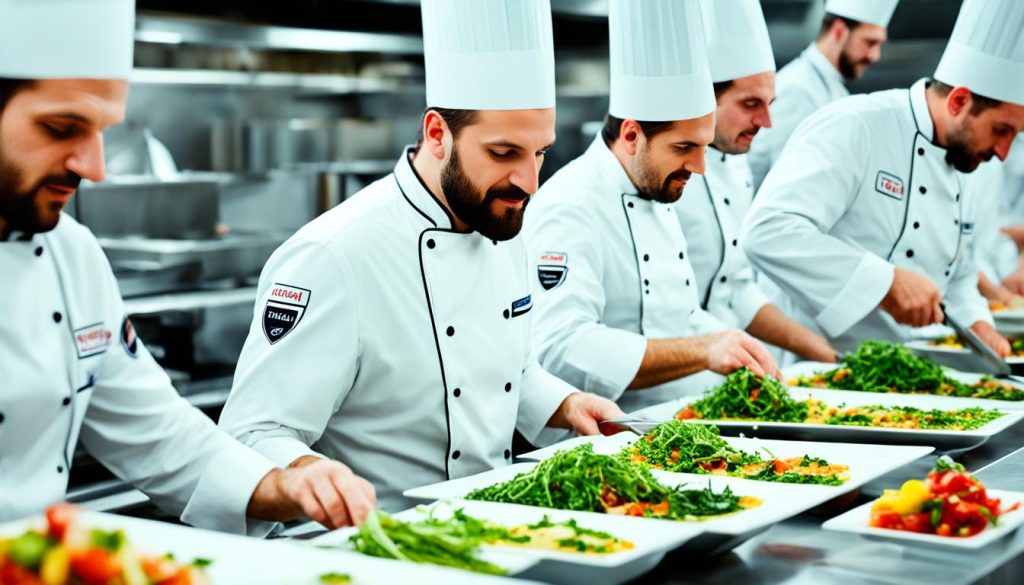
Italy’s food culture thrives on strict safety regulations and a strong commitment to quality. It’s not just about following the law. It reflects the Italian dedication to excellence in food. Let’s explore what makes Italy’s food sector stand out for its quality and dependability.
European Union guidelines lay the groundwork for Italy’s food safety rules. These are among the world’s toughest. They ensure food made and packed in Italy passes thorough safety checks before it reaches consumers. Italian producers also often exceed these baseline standards to boost their product quality.
- Quality Certifications: Producers in Italy often pursue esteemed certifications like DOP and IGP. These certify the food’s authenticity and its specific regional origin.
- Regular Inspections: Authorities frequently inspect food production to ensure ongoing adherence to both national and international standards.
- Traceability Systems: Italian food production places a high value on traceability. There are strong systems to track food from the farm to the consumer. This transparency reassures consumers.
Italy’s standards for food quality significantly shape food handling, storing, and distribution practices. These standards showcase the Italian commitment to craftsmanship and quality known worldwide.
Italian food producers follow strict legal frameworks covering production aspects. These include hygiene, use of preservatives, labelling, and packaging. This care safeguards consumers and maintains Italy’s reputation for food excellence.
- They use advanced hygiene practices in food processing to avoid contamination and ensure food quality.
- They limit the use of preservatives and additives, favouring natural ingredients instead.
- Labels clearly inform consumers about ingredients, allergens, and nutritional values.
Italy beautifully marries tradition with regulation. Time-honoured culinary methods are preserved alongside modern health and safety standards. Whether it’s enjoying Parmigiano-Reggiano or Chianti, one can be assured of the high standards and regulations ensuring Italy’s food quality. This careful attention strengthens Italy’s global food industry vision.
Sustainability Practices Within the Industry

The Italian food and beverage industry is leading with eco-friendly efforts due to growing green concerns. It commits to the planet through reduced food waste. This matters to customers who prefer sustainable food making and smart eating.
Efforts to Minimise Food Waste
There are several steps to lessen food waste, from farms to our tables. Leftover food is shared through community fridges. Restaurants also help by offering doggy bags to their diners.
- Technology is used for better stock control, helping to guess what will be needed and avoiding too much stock.
- Working with charities, the industry makes sure extra food helps those who need it, not wasted.
- There are campaigns to help consumers learn how to waste less food, like planning meals and keeping food correctly.
Adoption of Eco-Friendly Packaging Solutions
The move to greener packaging is key for sustainability. This includes:
- Choosing biodegradable materials to cut down on packaging waste impacts.
- Creating lighter and smaller packaging designs lowers transport emissions.
- Introducing reusable packaging invites customers to be part of a cycle of reusing containers.
Measures for Reducing Carbon Footprint in Food Production
Reducing the carbon footprint is a major goal. The industry is focusing on clean energy and efficient transport. Here’s how:
- Using solar energy and bioenergy in plants lessens fossil fuel use.
- Organic farming methods improve soil and store more CO2.
- Buying from local suppliers cuts the travel distance for food, making carbon emissions lower.
Through these green practices, the Italian food and drink industry leads in sustainable food making. It helps the environment and inspires other industries around the globe.
Technological Advances in Food Manufacturing

The Italian food industry is exploring new ways to be better. It’s focusing on using the latest food manufacturing technology. This includes automation in the food industry and biotechnology in food production. These changes are creating a future where making food is more precise and productive.
The Role of Automation in Production Efficiency
Automation is changing the game in the Italian food industry. It’s making things faster and more efficient. Now, machines and robots do the hard work, which means fewer mistakes. They handle ingredients, packing, sorting, and checking with great accuracy. This boosts how much can be made.
Improvements through Food Science and Biotechnology
At the same time, biotechnology in food production is making food that’s better for us and the planet. New fermentation methods are creating tasty, nutrient-packed options. Genetic engineering is helping crops to be stronger and produce more. This makes sure there’s always enough good stuff to make food with.
Challenges and Opportunities in Implementing Tech Innovations
Even though the future looks bright, bringing in new food manufacturing technology can be tough. The cost of fancy machines and training people is high at first. However, the benefits, like doing more with less waste and reaching new markets, make it worth it. Italian food makers have good reasons to use these tech advances.
This mix of old ways and new ideas is making the food manufacturing world exciting. It’s making the industry strong and ever-changing.
Exportation and Global Market Penetration
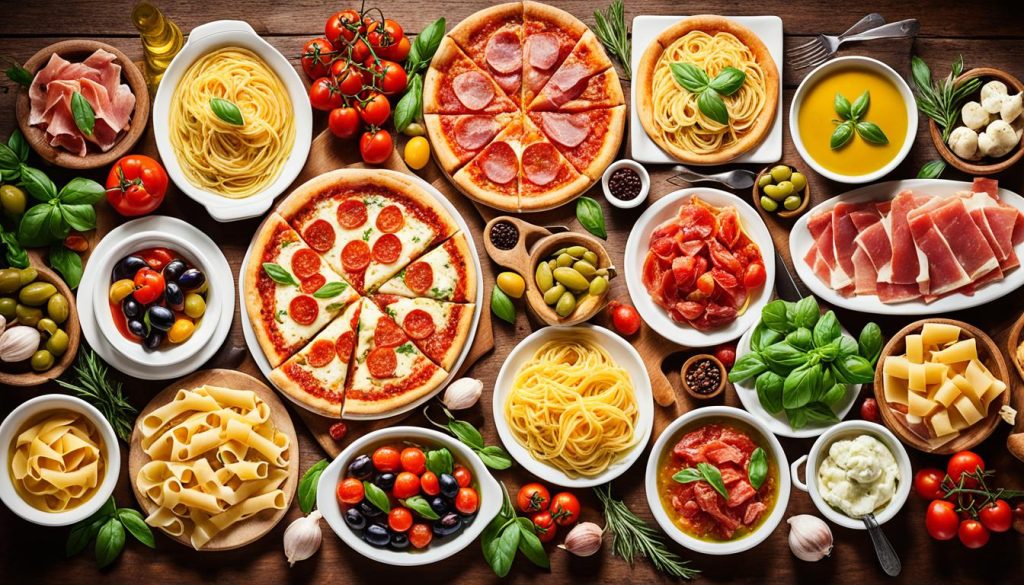
Italian food is making waves globally. Its success comes from a carefully crafted strategy that crosses borders. For those who love fine Italian cuisine, this growth is a sign of Italy’s commitment to sharing its culinary gems. The rise of Italian food around the world shows how well thought out export plans have played a key role.
Italian food producers are adapting and innovating in the global market. They ensure their products appeal to a wide range of tastes. This is part of a detailed strategy that considers what people in different areas like to eat. It also looks at how to market in various regions, helping boost Italy’s global standing.
- Penetrating new markets with tailored products
- Establishing joint ventures and partnerships overseas
- Adapting branding to align with local customs and languages
The mixing of old techniques with new marketing methods has pushed Italian food exports to the top. Italy is now a leader in the food industry worldwide. This blend of tradition and innovation invites people everywhere to explore the richness of Italian food.
- Analyse the correlation between export growth and targeted global market strategies.
- Evaluate the impact of international presence on brand and product reception.
- Review success stories of Italian brands that have achieved significant market share abroad.
Italy’s food industry is doing more than just sending its products overseas. It’s sending a message—inviting the world to enjoy a taste of Italian life. Many Italian brands, both big and small, have succeeded and grown in international markets.
Challenges Facing the Food and Beverage Industry in Italy
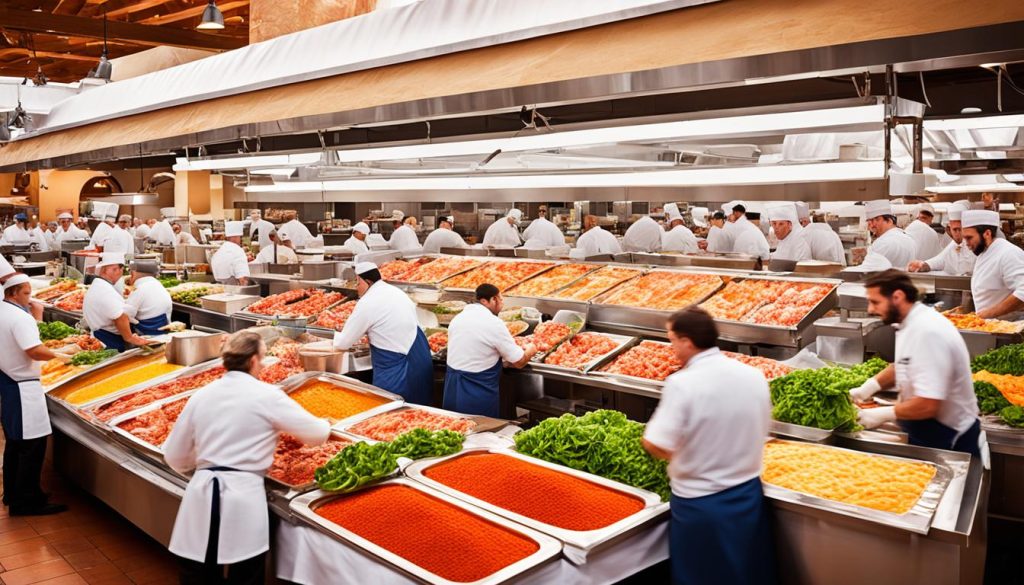
The Italian food and beverage sector is famous for its amazing flavours and deep traditions. Yet, it faces tough challenges like economic issues, supply chain problems, and changing regulations. Businesses need to be as tough as they are skilled.
Impact of Global Economic Fluctuations
Global economic changes greatly affect this industry. They impact the cost of ingredients and how much people spend. Since Italian food relies on local ingredients and traditional ways, these economic shifts hit hard. Businesses have to be smart and flexible to keep up.
Dealing with Supply Chain Disruptions
Managing the supply chain in this sector requires careful planning. Problems can come from many places, such as logistic issues or global events. Italian companies are finding new ways to keep their supply chains running smoothly. This ensures that Italian food remains top-quality everywhere.
Navigating Complex Regulatory Environments
Italy’s food and beverage sector is known for its high standards, thanks to strict regulations. But following these rules isn’t easy. Staying in line with both local and international standards is key. Industry leaders are working hard to make sure regulations keep quality high without slowing innovation.
Importance of Branding and Marketing in Italian Gastronomy

In the Italian culinary world, innovative Italian food branding and digital marketing
are vital. They help create a distinct identity in a market focused on realness and excellence. It’s quite a challenge to build brand loyalty, but it’s worth it. The use of geographical indications boosts marketing powerfully. These strategies improve brand recognition and connect more with customers.
Strategies for Building Brand Loyalty
Gaining brand loyalty requires ongoing quality and interaction. Brands need to embody the spirit of Italian food while proving their worth:
- Educating customers on the heritage and craftsmanship behind products.
- Creating loyalty programs that reward regular buys.
- Collecting feedback to refine and customise experiences.
This loyalty drives repeat purchases and turns customers into brand champions. They share their passion for authentic Italian food with others.
Leveraging Social Media and Digital Platforms
In the digital age, Italian food brands are engaging audiences uniquely:
- Using social media to post delicious images and tell their stories.
- Working with influencers and food bloggers for broader reach.
- Applying SEO techniques to boost online presence and draw in traffic.
This digital approach lets brands connect with consumers instantly, answer their questions, and build a community of food lovers.
The Power of Geographic Indication Status
Geographical indications are more than labels—they signify quality and tradition. They tell customers the product is genuine and traditionally made:
- Highlighting the GI status in ads to show product uniqueness.
- Working with certifying bodies to prove and share compliance.
- Using stories of the product’s origin to tie customers to the food’s homeland.
This approach not only builds trust but also adds exclusivity to the products. It shows their alignment with the famous Italian culinary tradition.
These essential strategies enhance the global image of Italian gastronomy. By combining time-honoured methods with current marketing, Italian food brands remain exemplary. They attract new food lovers and uphold Italian cuisine’s esteemed reputation worldwide.
Investment and Funding for F&B Start-Ups
The food and beverage industry in Italy is full of dynamic investments. It shows how the country supports innovative food businesses. Entrepreneurs have many ways to help their food business grow successfully.
Venture capital firms are keen on new F&B business models. They provide money and mentorship. Start-ups need to make their pitches stand out by showing their unique ideas and growth potential. A clear vision and a solid business plan are crucial.
The Italian government offers grants and incentives for food innovation. These include tax breaks and support for sustainable farming. It encourages organic production too.
- Assessing the range of venture capital options for start-up investment
- Understanding government grants and subsidies aimed at the F&B sector
- Exploring success stories: From initial investments to market presence
Italy’s rich culinary heritage, combined with these financial supports, leads to success. Many ventures have grown with this support. The food and beverage sector in Italy keeps growing. With innovation, investment, and government help, Italian start-ups are making their mark worldwide.
Case Studies of Successful Italian Food and Beverage Companies
We take a close look at Italy’s food and drink market to uncover why some companies do so well. They show us valuable business lessons with their innovative ideas. These companies, both big and small, highlight the smart ways of Italian food making.
Analysing Market Leaders and Their Strategies
Italy’s leading food businesses have raised the bar in quality and marketing. Companies like Barilla and Lavazza excel with their creative branding and worldwide outreach. They are seen as icons of Italian food culture, always staying true to their roots while appealing worldwide.
Lessons from Fast-Growing Small and Medium Enterprises
At the other end, SMEs are thriving with their unique stories. They grow fast by focusing on certain customer groups, both in Italy and beyond. They rely on trends like local ingredients and eco-friendly methods, showing small businesses can thrive with the right focus.
Innovation as a Key to Ongoing Success
In the competitive world of food, innovation is crucial. Leading firms use new tech and creative ideas to stay ahead. They’re moving towards greener options and direct online sales, appealing to modern consumers, ensuring their success continues.
Culinary Tourism and Its Influence on the Economy
Italy’s culinary excellence draws people from all over the world. This turns culinary tourism in Italy into a key part of the country’s economy. When food and wine lovers visit, local economies grow. This shows the economic power of food tourism.
The Synergy between Gastronomy and Travel
Eating well is more than just good food. It’s about experiencing the culture, tradition, and stories of a place through its dishes. This bond between food and travel proves Italy’s effort to share its culinary heritage within a larger cultural story.
How Culinary Experiences Drive Tourist Attraction
- Interactive cooking classes with local chefs
- Wine tasting tours in regions like Tuscany and Piedmont
- Visits to traditional markets and producers of delicacies such as Parmigiano-Reggiano
- Seasonal food festivals celebrating regional dishes and ingredients
These unique food experiences draw tourists who want to truly taste Italy. This boosts tourism and increases spending in accommodation and local shops.
Supporting Local Businesses through Tourism
Food tourism benefits local economies greatly. It helps small family-owned eateries and artisan food makers thrive. Tourists eager to bring a piece of Italy home also help the local food retail.
The impact of food tourism goes beyond enjoying delicious meals. It supports community growth, keeps food traditions alive, and plays a big role in Italy’s economy.
Conclusion
As we wrap up our journey through Italy’s food and beverage industry, it’s important to celebrate its unique charm. We’ve seen how tradition meets innovation in Italy’s culinary scene. From age-old recipes to the latest health-focused foods, Italy stands out. The industry also significantly boosts Italy’s economy through exports, job creation, and its contribution to the GDP.
The future of this industry looks bright and ever-changing. It’s moving forward with new technologies, eco-friendly efforts, and smart marketing. These steps aim to meet worldwide consumer needs while protecting our planet. Embracing green practices makes the industry more appealing globally.
Challenges are part of the industry’s journey towards growth. However, Italy’s food sector uses innovation to overcome these hurdles. It shows that with hard work and smart thinking, obstacles can lead to greater success. The delights coming from Italy have touched people everywhere. It shows the power of passion and business smarts combined. We can’t wait to see what delicious achievements the future holds.

